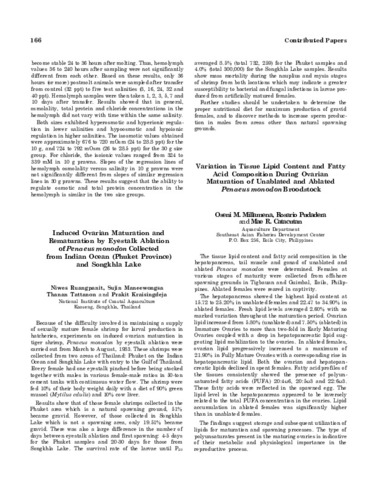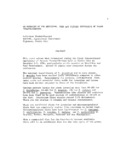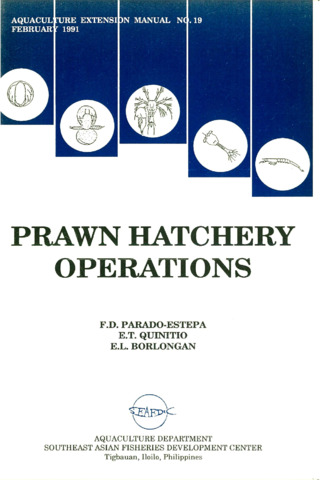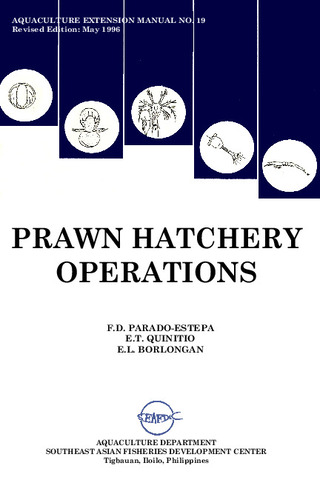Variation in tissue lipid content and fatty acid composition during ovarian maturation of unablated and ablated Penaeus monodon broodstock
Share
Abstract
The tissue lipid content and fatty acid composition in the hepatopancreas, tail muscle and gonad of unablated and ablated Penaeus monodon were determined. Females at various stages of maturity were collected from offshore spawning grounds in Tigbauan and Guimbal, Iloilo, Philippines. Ablated females were reared in captivity.
The hepatopancreas showed the highest lipid content at 15.72 to 25.20% in unablated females and 22.47 to 34.90% in ablated females. Fresh lipid levels averaged 2.60% with no marked variation throughout the maturation period. Ovarian lipid increased from 5.80% (unablated) and 7.50% (ablated) in Immature Ovaries to more than two-fold in Early Maturing Ovaries coupled with a drop in hepatopancreatic lipid suggesting lipid mobilization to the ovaries. In ablated females, ovarian lipid progressively increased to a maximum of 21.90% in Fully Mature Ovaries with a corresponding rise in hepatopancreatic lipid. Both the ovarian and hepatopancreatic lipids declined in spent females. Fatty acid profiles of the tissues consistently showed the presence of polyunsaturated fatty acids (PUFA) 20:4ω6, 20:5ω3 and 22:6ω3. These fatty acids were reflected in the spawned egg. The lipid level in the hepatopancreas appeared to be inversely related to the total PUFA concentration in the ovaries. Lipid accumulation in ablated females was significantly higher than in unablated females.
The findings suggest storage and subsequent utilization of lipids for maturation and spawning processes. The type of polyunsaturates present in the maturing ovaries is indicative of their metabolic and physiological importance in the reproductive process.
Description
Abstract only.
Suggested Citation
Millamena, O. M., Pudadera, R., & Catacutan, M. R. (1985). Variation in tissue lipid content and fatty acid composition during ovarian maturation of unablated and ablated Penaeus monodon broodstock (Abstract only). In Taki Y., Primavera J.H. and Llobrera J.A. (Eds.). Proceedings of the First International Conference on the Culture of Penaeid Prawns/Shrimps, 4-7 December 1984, Iloilo City, Philippines (p. 166). Iloilo City, Philippines: Aquaculture Department, Southeast Asian Fisheries Development Center.
Taxonomic term
Related items
Showing items related by title, author, creator and subject.
-
An overview of the nutrition, feed and feeding techniques of prawn penaeid/shrimps
Piedad-Pascual, Felicitas (Philippine Council for Aquatic and Marine Research and Development, 1989)This paper echoes what transpired during the first International Conference of Penaeid Prawns/Shrimps held in Iloilo City in December 4-7, 1984, particularly on the Nutrition nd Feed Development. Around 25 papers were ... -
Prawn hatchery operations
Parado-Estepa, Fe D.; Quinitio, Emilia T.; Borlongan, Emeterio L. (Aquaculture Department, Southeast Asian Fisheries Development Center, 1991-02)The manual, an updated version of the 1984 SEAFDEC/AQD manual, presents the underlying principles and step-by-step instructions of prawn larval and post-larval rearing. The techniques described are not only applicable to ... -
Prawn hatchery operations
Parado-Estepa, Fe D.; Quinitio, Emilia T.; Borlongan, Emeterio L. (Aquaculture Department, Southeast Asian Fisheries Development Center, 1996-05)The manual, an updated version of the 1984 SEAFDEC/AQD manual, presents the underlying principles and step-by-step instructions of prawn larval and post-larval rearing. The techniques described are not only applicable to ...





